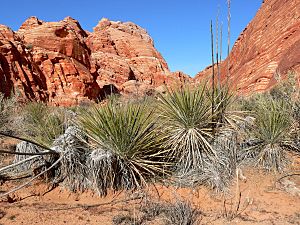Yucca utahensis facts for kids
Quick facts for kids Yucca utahensis |
|
|---|---|
 |
|
| Scientific classification | |
| Synonyms | |
|
The Utah Yucca (scientific name: Yucca utahensis) is a cool plant that belongs to the Asparagaceae family. This family includes many different plants, like asparagus and some types of lilies. The Utah Yucca is special because it grows naturally in the dry, sunny lands of Utah, Nevada, and Arizona in the United States.
Contents
Discovering the Utah Yucca
The Utah Yucca was first officially described by a scientist named McKelvey. This happened in 1947, which means it has been known to science for over 75 years! It's an important part of the desert plant life in these states.
What Does the Utah Yucca Look Like?
The Utah Yucca is a really interesting plant with a unique appearance.
Size and Stems
While some Utah Yuccas can grow quite tall, up to 10 feet (3 m) (about 10 feet), most of them are much shorter. They often have several stems that grow from the base, forming small groups or "colonies" of plants. Sometimes, these stems can even lie flat on the ground.
Leaves and Flowers
The leaves of the Utah Yucca are long and thin, like needles. They can be up to 70 centimeters (about 27 inches) long, but they are usually less than 2 centimeters (less than an inch) wide. Along the edges of the leaves, you might see thin fibers that look like threads.
When the Utah Yucca blooms, it produces beautiful flowers. These flowers are a creamy white color and hang downwards, looking like little bells.
Fruit and Seeds
After the flowers, the plant grows a fruit. This fruit is a dry pod, called a capsule. Inside the capsule, you'll find small, black seeds. These seeds are how the Utah Yucca makes new plants.
Where Does the Utah Yucca Grow?
The Utah Yucca is a native plant to the southwestern United States. It thrives in the desert and dry areas of:
It's well-adapted to living in places with little water and lots of sunshine.
See also
 In Spanish: Yucca utahensis para niños
In Spanish: Yucca utahensis para niños

